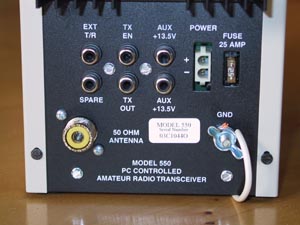From
the first view, the Pegasus looks like a very 'different radio'. It has
got no conventional front panel, no knobs to turn, it really looks like
a Mini-Tower PC. In fact, almost all transceiver functions are
controlled from a PC running MS-Windows (tm) software (sorry, no Mac
support).
Update 12-Dec-2009:
>> Pegasus schematics files can be downoaded here (16 MB zipped PDF!) <<
All rights reserved: paper copies Ten-Tec, scans DK3QN
Thanks to Paul at Ten-Tec for providing the paper copies of the Pegasus schematics
and giving me permission to scan them and make the scans available on my website.
Update 12-Dec-2009:
>> Pegasus schematics files can be downoaded here (16 MB zipped PDF!) <<
All rights reserved: paper copies Ten-Tec, scans DK3QN
Thanks to Paul at Ten-Tec for providing the paper copies of the Pegasus schematics
and giving me permission to scan them and make the scans available on my website.
The interfaces to connect this 'box' are located both on the front as well on the rear panel.
On the rear panel you can find the connectors which you may have suspected to find there, mainly the 12 volts DC connector, antenna connector and some other connectors.
On the front panel there is the power switch and a number of connectors like the serial port connector for the connection to the PC, audio outlets, accessory outlet, etc.
With all these connectors coming out of the front of the transceiver the appearance of the box is not very pleasing. I suspect 2 reasons for Ten-Tec having the layout done like this: #1, there is not enough space on the rear panel to integrate all connectors there (because of the relatively large heat sink covering most part of the rear panel), and #2, because of the internal PCB mounting and easier cabling from the PCBs to the front panel.
Anyway, one does not really want to have this box sitting just in front of him or her, like we usually do with other 'normal' ham gear.
On the other hand, there's no need to have the box in front of you as almost everything is controlled from your PC. The only two things you need to check there is whether the Pegasus is powered-on and an occasional glance at the ALC LED indicator tells you if the Mike gain setting is all right (the LED should light only at voice peaks).
The rest of the game happens all in software, well almost...
Connecting a mike, key(er) etc. is a standard procedure.




Ten-Tec
provides a software together with the transceiver, so hooking it up is
quite easy. There is an alternative source of software which is written
and distributed by N4PY. You can read reviews on this software at
www.eham.net.
I ordered the N4PY software this week (end of January 2003) via email, payed with PayPal (USD 35) and got the software emailed from him within a day. I will post my experience somewhere on this website as soon as I have made more use of it.
Now that you have installed the hardware plus the software you are ready to go. The man-machine-interface is completely implemented in the software's GUI. From there you just control every function of the transceiver by moving (software) sliders, push buttons etc.
It takes some time getting used to this kind of operation.
What I have added to the Pegasus are 2 things:
1. I connected a pair of small active loudspeakers with a volume control, which I placed within reach so that I can control the audio volume manually instead of having to adjust the (software) volume slider.
2. I purchased the optional keypad/knob add-on which allows frequency adjustments in the 'old-fashioned' way by turning a rotary VFO knob plus it has got a number of keys including 'number keys' where you can manually punch-in a frequency plus some function keys where a certain function can be programmed to.
Both of these options make life with the Pegasus much more conveniant.
All in all, this is a fun rig, especially interesting for digital modes where you can control the whole set-up from one PC through the use of multiple windows.
I ordered the N4PY software this week (end of January 2003) via email, payed with PayPal (USD 35) and got the software emailed from him within a day. I will post my experience somewhere on this website as soon as I have made more use of it.
Now that you have installed the hardware plus the software you are ready to go. The man-machine-interface is completely implemented in the software's GUI. From there you just control every function of the transceiver by moving (software) sliders, push buttons etc.
It takes some time getting used to this kind of operation.
What I have added to the Pegasus are 2 things:
1. I connected a pair of small active loudspeakers with a volume control, which I placed within reach so that I can control the audio volume manually instead of having to adjust the (software) volume slider.
2. I purchased the optional keypad/knob add-on which allows frequency adjustments in the 'old-fashioned' way by turning a rotary VFO knob plus it has got a number of keys including 'number keys' where you can manually punch-in a frequency plus some function keys where a certain function can be programmed to.
Both of these options make life with the Pegasus much more conveniant.
All in all, this is a fun rig, especially interesting for digital modes where you can control the whole set-up from one PC through the use of multiple windows.